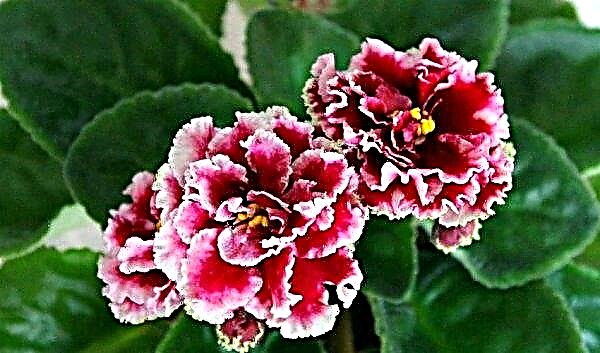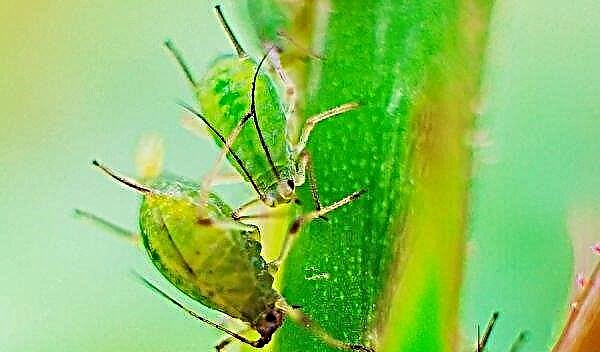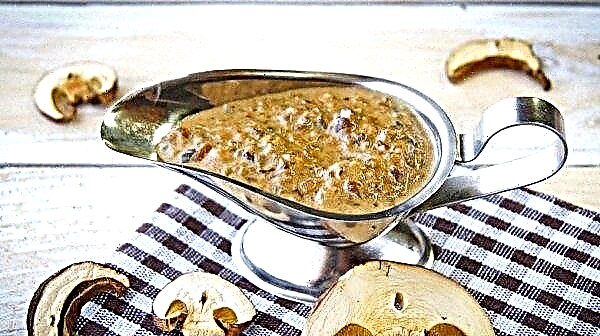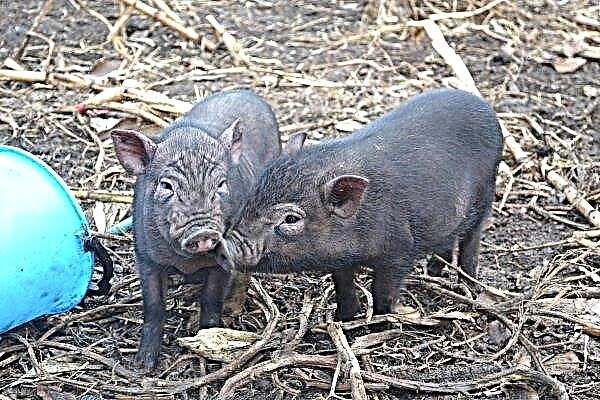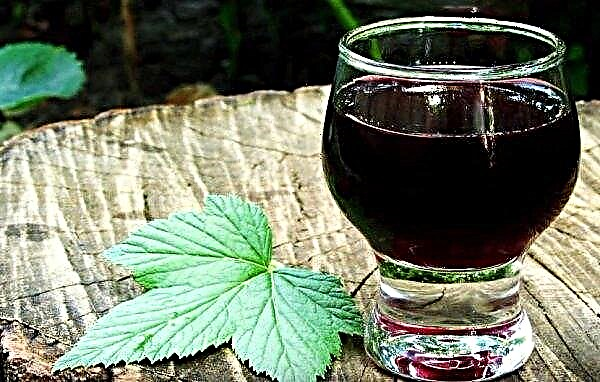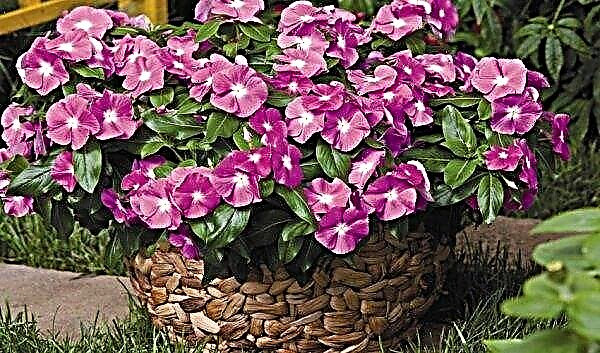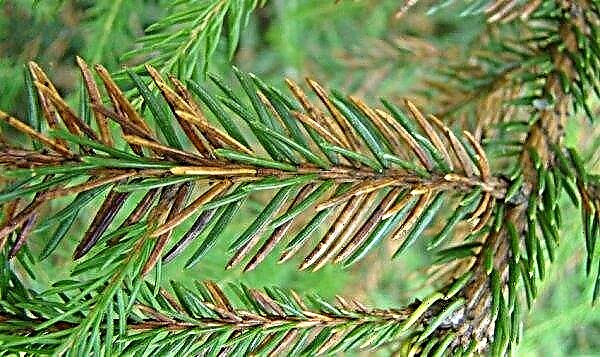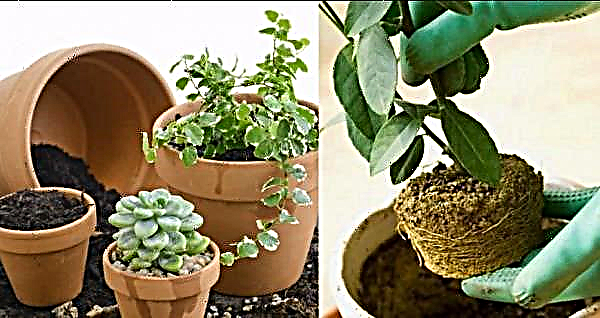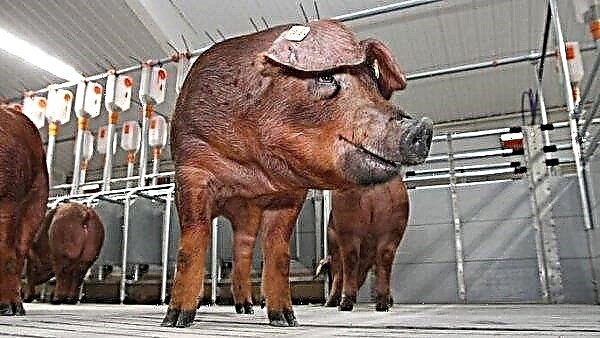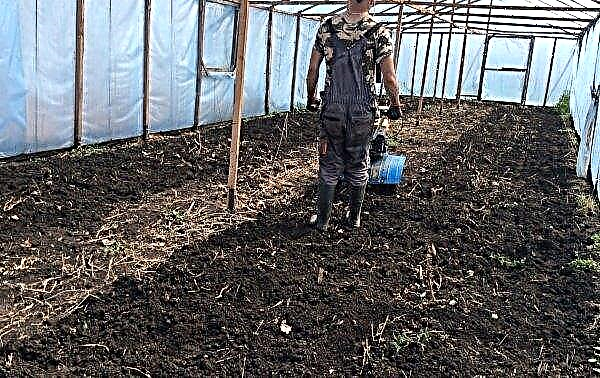When growing sweet peppers in a greenhouse, farmers often encounter pest attacks that can significantly reduce crop yields. In order to save the crop, it is necessary to notice the appearance of insects in a timely manner and begin an immediate fight against them. In the article, we consider a description of the main pests of pepper in the greenhouse, signs of their appearance and methods of control, as well as the necessary preventive measures.
The basic rules of growing pepper in a greenhouse
In the greenhouse, you can set the temperature and humidity level for the bell pepper bushes at which the plant yield will be maximum.
When growing pepper in a greenhouse, you need to adhere to some rules:Did you know? Only 40 g of sweet pepper contains the daily human need for vitamin C.
- Before planting peppers, the old soil layer is removed and replaced with fresh, fertile soil. It can be taken at the place of the site where last year zucchini, onions, cabbage or carrots were grown.
- Enrich the soil in the greenhouse with nutrients by applying fertilizers containing nitrogen, potassium, phosphorus and organics.
- Pepper seedlings are transplanted into the greenhouse after the seedlings have grown to 25 cm and 6-7 pairs of leaves have formed on them.
- At the time of transplanting, the temperature of the soil in the greenhouse should be at least + 15 ° С.
- Transplant dates depend on the region of cultivation and usually fall in the second half of May. For a heated greenhouse, it is permissible to plant seedlings in late March or early April.
- Transplanting seedlings is carried out in the evening. Bushes of pepper are placed according to the recommended planting scheme, leaving a distance of 15 to 35 cm between them (depending on the variety).
- After transplanting the sprouts, the earth around them is slightly compacted and mulched with humus.
- For growth, you need to provide plants with good access to sunlight. If the walls of the greenhouse are made of a transparent film, then seedlings are recommended to be shaded from direct sunlight.
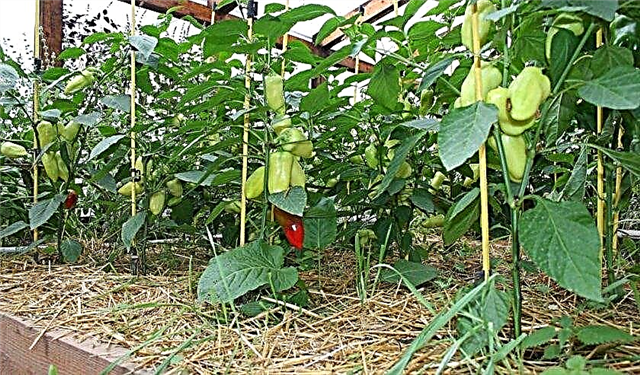
- The air temperature in the room should be kept at least + 23 ° С, but no more than + 30 ° С, avoid sudden temperature changes.
- Bushes of pepper are regularly watered with warm water under the root as the soil dries. The frequency of watering is 1-2 times a week.
- To improve the air permeability of the soil spend its loosening.
- The humidity level in the greenhouse should be 70–75%. It is necessary to carry out regular ventilation of the greenhouse to avoid stagnation of air, but to prevent the appearance of a draft.
- To protect against weeds, beds with pepper are mulched with a layer of sawdust or compost.
- Organic fertilizers are applied during the flowering period of plants and during the ripening of fruits with an interval of 2 weeks. Bushes need to be fed with a complex mineral fertilizer containing potassium and superphosphate once a month.
- If the pepper variety is medium-tall or tall, they form bushes by pinching the side shoots, removing stepsons and pruning leaves.
- If the plants are tall, you need to install a trellis or any vertical support. A bush is tied to it so that it does not fall on its side under the weight of the fruit and maintain its balance.
- Harvesting can begin in mid-July and continue through September. At the same time, ripened fruits must be carefully cut with secateurs along with the peduncle. This procedure is carried out every week.
Pests of pepper in a greenhouse
Sometimes the pepper bushes in the greenhouse begin to wither and stop growing. This can lead to crop loss, so you need to correctly determine the cause of the problem and take measures to eliminate it. The reason for the deterioration of the appearance of plants can be not only improper care, but also the appearance of pests that eat leaves and fruits.
Next, we consider the characteristics and signs of the appearance of various pests of pepper in the greenhouse.Important! To start the treatment of pepper bushes, you need to determine which particular insect or caterpillar attacked the plant, and choose the right pest control methods.
Naked slugs
These pests may not seem very dangerous for peppers, as they have weak jaws and move slowly. But due to their gluttony, slugs can cause serious damage to the crop.
Consider their description in more detail:
- Slugs have an elongated and soft trunk up to 6 cm long. Their color can be light brown or dark.
- Pests leave behind a viscous transparent mucus that forms a thin layer on pepper leaves and provokes the development of fungal diseases.
- Slugs eat leaves and fruits of pepper bushes. They appear on plants mainly at night, and during the day they sleep in the upper layers of the soil.
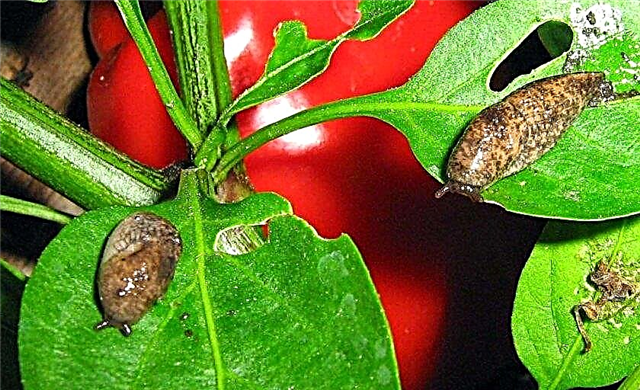
The following signs indicate the appearance of slugs in the greenhouse:
- transparent slippery coating on the leaves and stem;
- round holes in the central part of the leaf and on the fruits;
- rotting of pepper;
- the presence of slugs in soil cracks near plants.
Shield
The insect is a dangerous plant pest and can harm not only the green mass of the bush, but also the fruit.
Consider its characteristics in more detail:
- The scabbard is very small, the diameter of its round body is about 2 mm. On top of the insect's body is covered with a protective shield of brown color with a small layer of wax coating.
- Larvae quickly spread over the leaves and cover the surface of the plant with round dark plaques.
- Scabies not only suck out juices from the leaves, but also cover them with sticky coating (pad), which serves as a favorable environment for the propagation of fungal spores.

- the appearance of small yellow or brown growths on the leaves and fruits;
- stopping the growth and development of the bush;
- sticky coating on the surface of the sheet plate;
- yellowing, twisting and falling of leaves.
Did you know? Female scale insects are the only insects that gradually move to a fixed lifestyle and feed continuously.
Whitefly
The butterfly has a bright appearance, but hides well on the inside of the leaf. In order to notice the pest in time, you need to know the description of its appearance.
Let's consider it in more detail:
- Whitefly has a light yellow body about 5 mm long and wings covered with white plaque - visually it resembles fine flour.
- The insect larvae are painted in a transparent color and resemble tiny growths located on the lower surface of the leaves.
- As a result of the vital activity of the caterpillar, a special sticky substance (pad) containing fungal spores is secreted. They are the causative agents of various fungal diseases of plants (powdery mildew, gray rot, etc.).
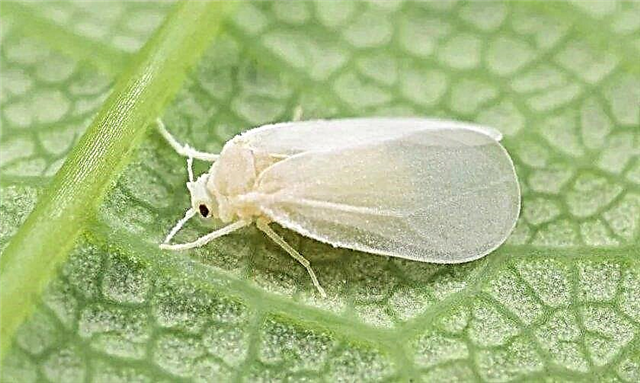
The signs of the appearance of whiteflies on plants are as follows:
- when shaking the branches of a bush, a swarm of small white insects takes off from the leaves;
- sticky coating on the lower surface of the sheet;
- yellowing of the green mass of the plant, accompanied by its wilting;
- the leaves turn black and fall off.
Aphid
These pests not only eat green leaves and shoots of pepper in the greenhouse, but also attract ants to the beds. Aphid colony is able to quickly destroy all plants, as well as provoke their infection with various fungal infections.
The main characteristics of the pest are presented below:
- The body length of aphids does not exceed 0.7 mm. Insects are painted in light green color and suck out juices from leaves using an elongated proboscis.
- As a result of their life, insects leave a sticky coating on the leaves, which can serve as a source of pathogenic fungus.
- The pest nibbles all the leaves of the bush, leaving a naked "skeleton" from them. After such damage, the plant does not recover.
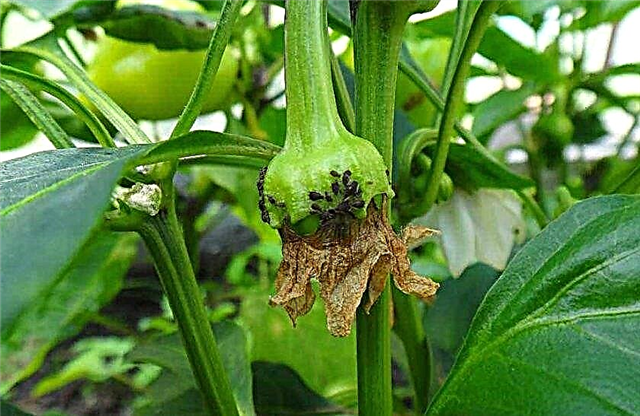
The appearance of aphids on pepper bushes is evidenced by such signs:
- small groups of small green insects on the surface of the leaf;
- transparent sticky coating on the leaves;
- the presence of ants on the stem or around it;
- gnawed edges of the sheet plate;
- yellowing and twisting of leaves;
- slowing the growth of the bush, twisting its top;
- drying of inflorescences and deformation of the fruit.
Important! Ants can also harm pepper bushes, but they leave the place on their own after all the aphids on the plant die.
Spider mite
This pest feeds on plant juices and can quickly destroy the green part of the bushes. As a result of this, the formed fruits will not be able to ripen, and the crop of peppers will be lost.
Consider the description of the spider mite:
- The insect is small arachnid, the length of its body does not exceed 0.5 mm. At first the body of the pest is translucent, but then it turns red or orange.
- The spider mite attaches to the inner surface of the leaves and sucks the juice out of them. It moves from an infected plant to a healthy one through water, soil, and garden tools.
- The insect is a thin web covering all parts of the plant.

Signs of the appearance of a spider mite on pepper bushes in a greenhouse are:
- spider web on the inside of the leaf;
- small holes in the leaves;
- falling of inflorescences and ovaries;
- yellowing and wilting of green mass.
Wireworm
This pest is especially dangerous, since it acts exclusively underground and can quickly destroy a plant. If the wireworm strongly damages the underground part of the bush, then it will not be possible to save the crop.
Consider the characteristics of the pest in more detail:
- The wireworm is the larva of a nutcracker, which lays eggs in the soil in the first half of summer. The body of the caterpillar is painted dark brown and has a hard surface. The length of an adult worm is up to 5 cm.
- The larva lives exclusively in the soil and feeds on the roots of the bushes and young shoots of pepper. It can survive the cold winter and remains viable for 5 years.
- The caterpillar damages inflorescences and young fruits, causing them to fall off or rot.

The following symptoms indicate the appearance of a wireworm in a greenhouse:
- the presence of brown larvae on the lower surface of the stem and in the upper layers of the soil;
- yellowing and wilting of leaves;
- slow growth of the bush;
- falling of inflorescences, decay of fruits.
Scoop
This pest is distinguished by an inconspicuous appearance, and the peak of its activity falls at night. Caterpillars of scoops can cause irreparable damage to pepper bushes and reduce productivity.
Consider the main characteristics of the pest:Did you know? One of the largest insects is the agrippin scoop. The wingspan can reach 31 cm.
- Butterflies scoops are small, have a dark brown color. Their wingspan is about 5 mm. On each wing you can see a wavy line of light gray color and small round spots with a white border.
- The caterpillar of the scoop is green. A green line stretches along its entire body, and transverse lines are visible on the back.
- Caterpillars hatch in the summer and begin to eat leaves of bushes and fruits of pepper. Pests act at night, and during the day they hide in the upper layers of the soil.
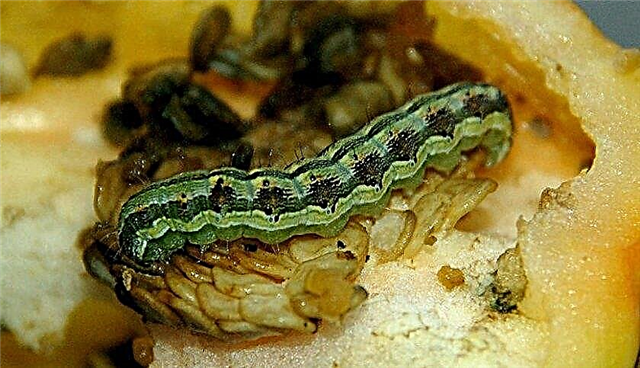
Signs of the appearance of scoops on plant bushes include:
- gnawed edges of the leaves, minor damage to the fruit;
- yellowing and wilting of the green mass of the bush;
- slowing plant growth.
Thrips
Visually, thrips are a bit like small grasshoppers, so it can be difficult to notice their appearance on pepper bushes in a greenhouse.
Consider the description of these pests in more detail:
- The body of thrips is translucent or dark brown, has an oblong shape and can reach a length of 1.5 mm. The abdomen of insects is striped, and the head has a slightly sloping cylindrical shape. On the edges of the wings are small hairs resembling a fringe.
- The thrips are flashed from one plant to another, rapidly spreading throughout the site.
- Larvae and adults suck out the juice from the leaves of the plant, which provokes the wilting of the green mass and the death of the entire crop. Pests are also carriers of various diseases.
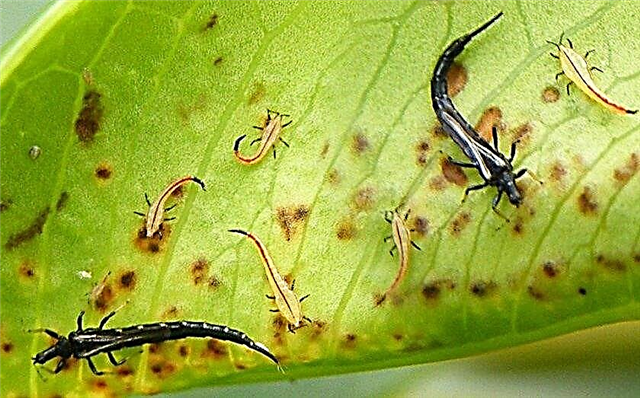
Signs of thrips on pepper bushes are:
- the appearance on the surface of leaves of small yellowed spots or stripes;
- when shaking the branches of the bush, insects show off from them in the form of small oblong dust particles;
- pepper leaves turn yellow and die.
Colorado beetle
A feature of the pest is that it quickly develops immunity to poisons, so it is very difficult to completely destroy it.
The main characteristics of the Colorado potato beetle are listed below:
- Insects have a trunk about 1.2 cm long, covered with a black and white striped carapace on top. The cephalothorax is yellow, covered with black dots.
- The eggs of the insect have a bright yellow color, arranged in heaps. The larvae reach a length of 1.5 cm, painted brown or pinkish.
- Insects tolerate winter well and are not an attractive bird food. The leaves of pepper are eaten by both the larvae and the beetles themselves.
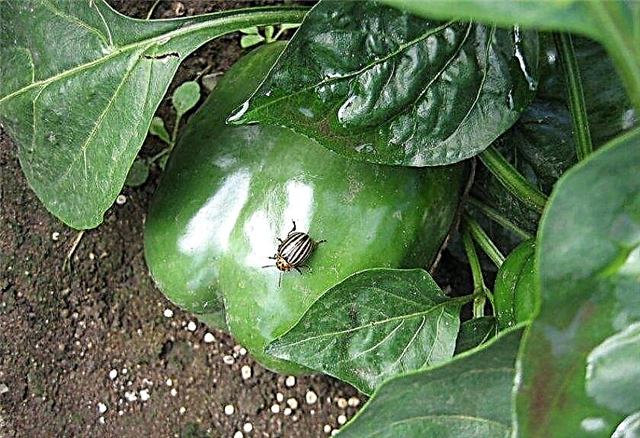
The following signs indicate the appearance of a pest on pepper bushes:
- the presence of insects on the stem and leaves, as well as on the ground around the plant;
- the appearance of yellow egg clutches on the lower surface of the leaf;
- leaves and shoots of a bush nibbled at the edges;
- the presence on the plant of pink larvae eating leaves.
Important! Only one female Colorado potato beetle per season can lay up to 1000 small eggs.
Medvedka
This pest is relatively large and looks intimidating. In addition to pepper, the bear can eat other vegetables and even earthworms.
Consider the description of the pest:
- The torso of the bear has a length of about 8 cm, and the cephalothorax is covered with a strong dark carapace. The wings have an oblong shape, and in the front are digging limbs. The tail is bifurcated.
- The insect lives deep underground, breaking through long narrow passages in it.
- Medvedka knows how to fly, quickly moves underground and swims well. It can quickly move around the site, causing hardly underground parts of pepper bushes.
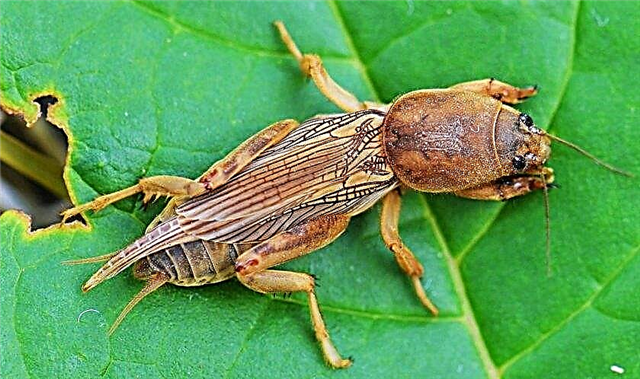
Despite its large size, the appearance of a bear near pepper bushes is difficult to notice, since it only damages their underground part. Pests can only be detected by the characteristic narrow passages in the ground that lead from one plant to another.
Grub
These pests live in the upper soil layer for 3-4 years and successfully tolerate even cold winters.
Consider the main characteristics of the larvae of the cartilage:
- The larvae have a thick white body twisted into a ring with transverse stripes. There are 3 pairs of dark brown legs on it.
- The longevity of the caterpillars is 3-4 years; they winter in the soil at a depth of 1-2 m. Gluttony of pests increases with age.
- In the warm season, caterpillars live at a depth of 10–20 cm and eat plant roots. They especially love young seedlings, but often eat adult bushes of peppers.
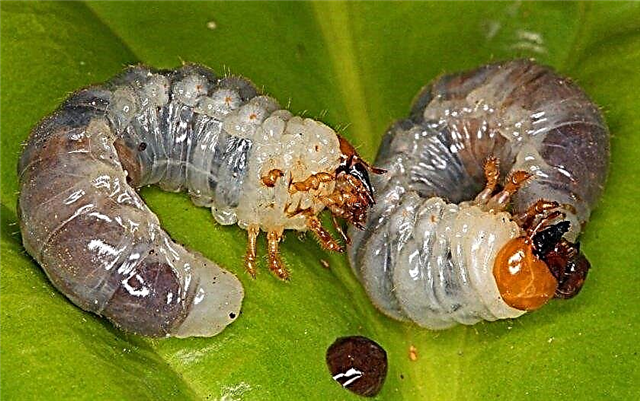
Signs of damage to the pepper bushes with the larvae of the May beetle are:
- the presence of white caterpillars in the upper layers of the soil;
- yellowing and wilting of the green mass of the bush;
- stopping the growth and development of the plant;
- weakening of the root system - the bush is easily pulled out of the soil.
Did you know? According to the laws of aerodynamics, the May bug should not fly, since its body mass is too large compared to the wings.
What to do and how to process pepper?
Depending on which pest has settled on the bush of pepper, choose the appropriate treatment. If the number of insects is small, you can try to cope with them using folk remedies. In the case when there are a lot of pests or the area of infection is large, it is recommended to use chemicals.
To get rid of whiteflies in a greenhouse, you can perform the following actions:
- wash off pests from pepper leaves with water, wipe the leaves with a soapy solution;
- treat the room with smoke from sulfur drafts;
- sprinkle pepper with garlic infusion diluted with water.To prepare it, you need to insist 0.5 liters of water with a chopped head of garlic for a week, dilute the product with water before use (5 g of infusion will be needed for 1 liter of water);
- if necessary, use chemicals (Confidor, Mospilan).
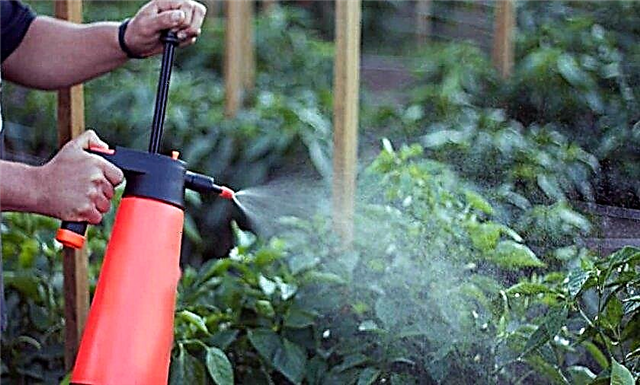
To successfully deal with the Colorado potato beetle, it is recommended to use the following methods:
- with a small number of pests, collect them manually and destroy them;
- to treat the bushes with an aqueous solution of wormwood and ash. To prepare it, you need to pour 10 liters of boiling water 200 g of wormwood leaves and a glass of ash. The remedy must be insisted for 2-3 hours;
- carry out chemical treatment of pepper with the help of special preparations (“Bitoxibacillin”, “Regent 800”).
You can get rid of a bear in a greenhouse using the following actions:
- put near the pepper traps, consisting of a small lamp and a container with kerosene - the bear will fly into the light and after hitting the lamp will fall into kerosene;
- in the period from late May to early June, inspect the topsoil around the pepper. If eggs or larvae of the bear are found in it, collect them manually and destroy them;
- processing the underground passages of the pest with soapy water (200 g of soap will be needed for 10 liters of water) In this case, the soil is impregnated to a depth of about 8-10 cm;
- the use of special preparations for cultivating the soil around peppers (Grizzlies, Phenaxin Plus).
Against a spider mite carry out such actions:Important! When using chemicals against pests, you must strictly adhere to the instructions indicated on the package.
- isolate all diseased pepper bushes;
- pour the plants with a warm aqueous solution of kerosene and laundry soap (10 g of water will require 2 g of kerosene and 40 g of soap);
- use an aqueous solution of tobacco and laundry soap for leaf treatment. To prepare it, pour 400 g of tobacco with 10 l of water and let it brew for a day. Then boil the resulting infusion for 2 hours, cool the mixture and add 50 g of soap and another 10 l of water to it;
- spray the bushes with special preparations against pests (Fitoverm, Inta-Vir).
To combat bare slugs, such methods are used:
- wrap pepper bushes with a film so that the slugs climb underneath it at night, and during the day die from extreme heat;
- inspect the soil around the bushes and, if pests are detected, collect them manually;
- water the recesses in the soil with slugs with hot water (about + 50 ° C);
- pour a layer of lime on the moist earth between the plants - falling on the body of the slug, lime burns it, and the pest dies;
- apply special chemicals (Thunderstorm, Meta, Ferramol).

To save the pepper crop from the invasion of scoops, they take the following actions:
- collect caterpillars manually in the dark;
- they use homemade butterfly traps - to create it you need to cut a plastic bottle, fill it with fermented jam to a third of the height and hang it at a distance of 1 m above the ground;
- apply chemicals ("Decis", "Arrivo").
To combat aphids, such means are used:
- attracting ladybugs and double-tails (earwigs) into the greenhouse, eating aphids - for this, coriander, caraway seeds or dill can be planted near the bushes;
- processing bushes with an aqueous solution of ash, tobacco and soap. To prepare the product, you need to mix 10 liters of hot water with a glass of tobacco and the same amount of ash. After the mixture is infused for a day, add 25 g of liquid soap and filter the finished solution;
- spraying plants with a solution based on garlic and soap. To cook it, you need to pour 250 g of chopped garlic 2 liters of boiling water, then leave the mixture to infuse for 24 hours. Add 20 g of laundry soap, strain the product and mix it with 8 l of water. Before use, the resulting infusion is mixed with water in a ratio of 1: 5;
- apply chemical control agents (Fitoverm, Karbofos).
To save the pepper bushes in the greenhouse from the invasion of thrips, carry out such actions:Did you know? Pepper contains the hormone of joy, which helps fight depression and improves well-being.
- if insects or larvae are found, wash them off the surface of the plant with a stream of water from a hose;
- spray pepper bushes with water infusion of marigolds. To prepare it, mix dry plants with warm water in a ratio of 1: 1 and leave to brew for 48 hours;
- treatment of plants with infusion of onions or garlic - take about 10 g of crushed product per 1 glass of water and infuse the mixture for a day;
- use of special chemicals (Vertimek, Actellik, Confidor).
To destroy the wireworm, use the following methods:
- add crushed chalk, crushed eggshells or wood ash to the soil to reduce soil acidity;
- prepare a caterpillar bait in the form of a stick with stringed sweet fruits, buried away from the beds with pepper. After a few days, the stick is dug out and all the pests that are on it are destroyed;
- chemical treatment of pepper bushes (Provotox, Calypso).
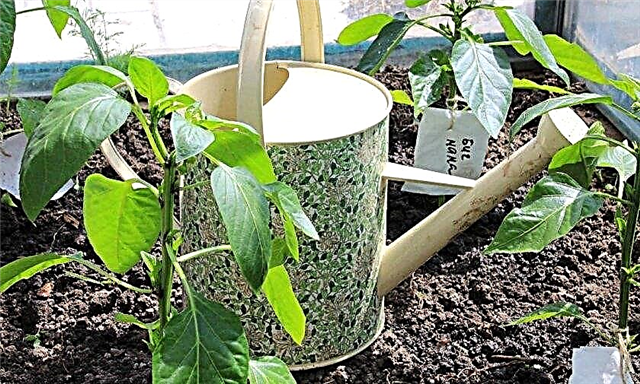
To get rid of the scab on pepper, take the following actions:
- with a small number of pests, remove them manually with a soft toothbrush, and then wipe the leaves with an alcohol solution;
- treat the leaves of the bush with an aqueous solution of soap and ammonia (for 2 liters of water you need to take 20 g of liquid soap and ammonia);
- rinse the leaves with onion infusion. To prepare it, you need to chop a small onion and pour it with a glass of water for several hours;
- apply chemicals ("Aktara", "Fury").
When the larvae of the May beetle appear in the greenhouse, they carry out such measures:Important! When using chemicals against pests, they should not be allowed to get on the fruit - they can accumulate toxic substances.
- carry out manual collection of pests by digging them in the upper layer of soil;
- water the plants with infusion of onion peel (pour the husk with water in a ratio of 1: 2 and insist for 5 days);
- with a significant number of caterpillars use chemicals ("Vallar", "Antichrush").
Pest Prevention
It is much easier to prevent the occurrence of a pest than to fight it and eliminate the consequences of its life. Accordingly, to increase the yield of pepper in a greenhouse, a set of preventive measures must be taken in a timely manner.
These include:
- regular inspection of pepper bushes for insects or larvae;
- planting garlic and calendula around pepper - their pungent odor repels pests;
- high hilling of plants in the middle of summer;
- regular weeding of weeds;
- periodic loosening of the topsoil;
- spraying pepper leaves with water to increase the humidity level in the greenhouse;
- removal of last year's crop residues;
- compliance with the planting scheme in the greenhouse;
- Autumn digging of the soil to a depth of at least 8–10 cm to destroy pest larvae wintering in the ground;
- planting next to pepper aromatic plants (dill, fennel, coriander) - their smell attracts a ladybug that eats aphids;
- regular ventilation of the greenhouse to improve air circulation;
- compliance with recommendations for watering and fertilizing.

In the process of growing sweet pepper in a greenhouse, bushes can be attacked by a wide variety of pests. Using the recommendations from this article, you can always identify the symptoms of plant damage and choose the appropriate treatment.

















